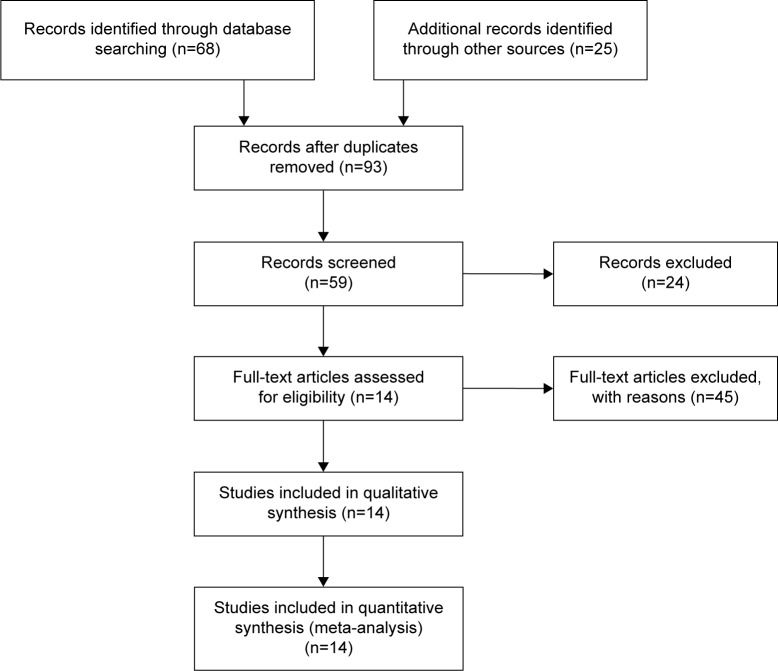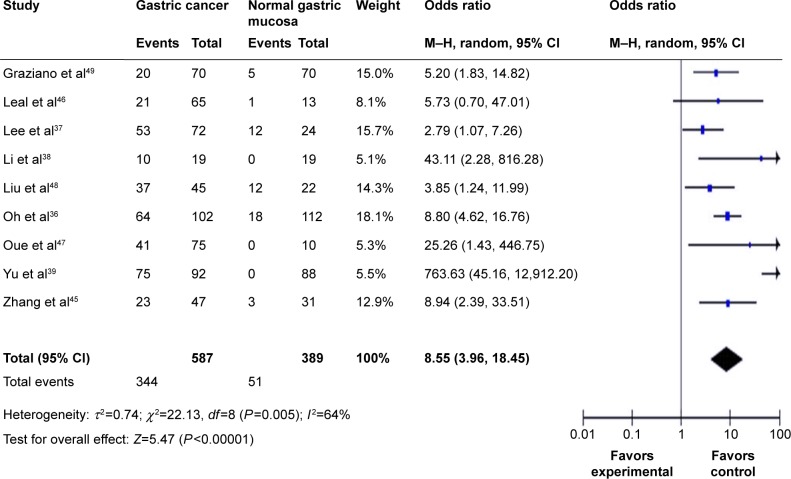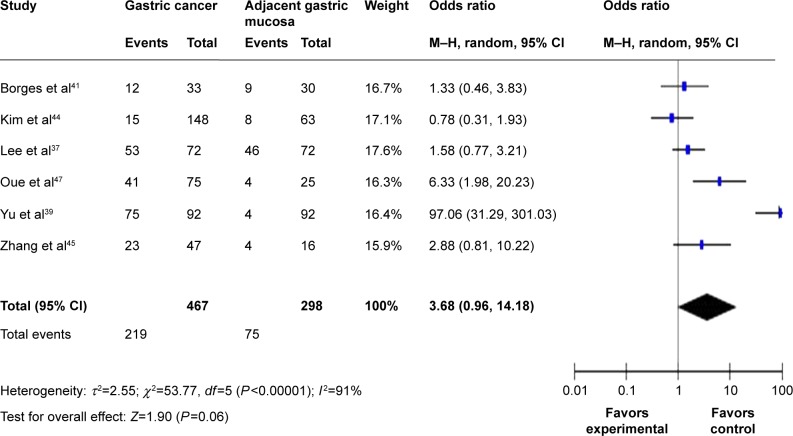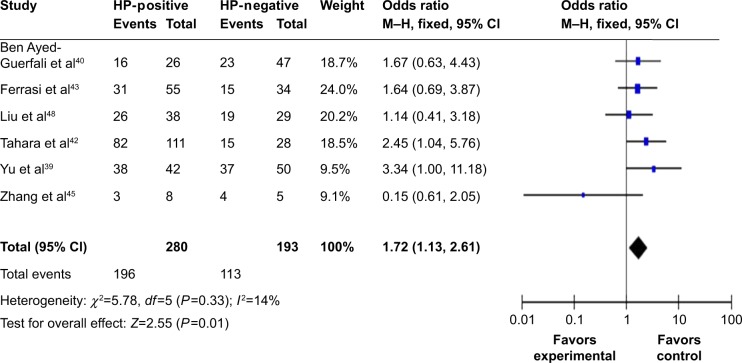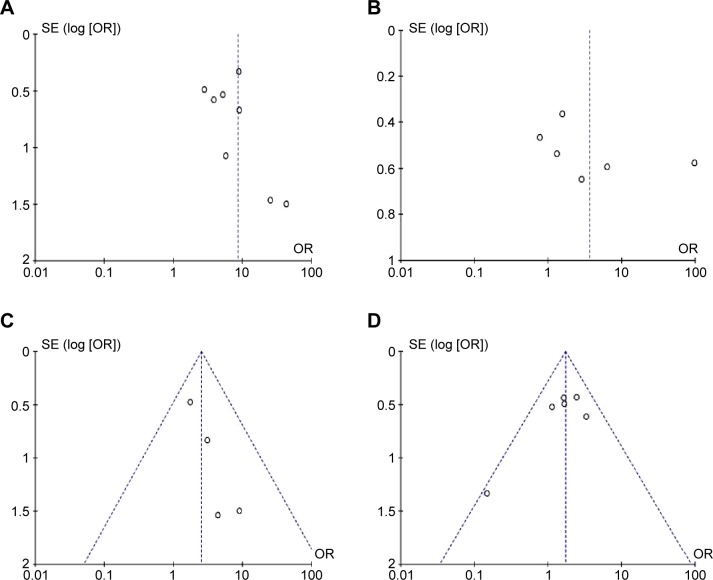Abstract
Background
CDH1 is a protein encoded by the CDH1 gene in humans. Loss of CDH1 function contributes to cancer progression by increasing proliferation, invasion, and/or metastasis. However, the association and clinicopathological significance between CDH1 hypermethylation and gastric cancer (GC) remains unclear. In this study, we systematically reviewed the studies of CDH1 hypermethylation and GC, and evaluated the association between CDH1 hypermethylation and GC using meta-analysis methods.
Methods
A comprehensive search of the PubMed and Embase databases was performed for publications up to July 2014. Methodological quality of the studies was also evaluated. The data were extracted and assessed by two reviewers independently. Analyses of pooled data were performed. Odds ratios (ORs) were calculated and summarized.
Results
A final analysis of 1,079 GC patients from 14 eligible studies was performed. CDH1 hypermethylation level in the cancer group was significantly higher compared to the normal gastric mucosa (OR =8.55, 95% confidence interval [CI]: 2.39–33.51, Z=5.47, P<0.00001). CDH1 hypermethylation was not significantly higher in GC than in adjacent gastric mucosa (OR =3.68, 95% CI: 0.96–14.18, Z=1.90, P=0.06). However, CDH1 hypermethylation was higher in adjacent gastric mucosa compared to that in normal gastric mucosa (OR =2.55, 95% CI: 1.22–5.32, Z=2.49, P<0.01). In addition, CDH1 hypermethylation was correlated with Helicobacter pylori (HP) status in GC. The pooled OR from six studies including 280 HP-positive GCs and 193 HP-negative GCs is 1.72 (95% CI: 1.13–2.61, Z=2.55, P=0.01).
Conclusion
The results of this meta-analysis reveal that CDH1 hypermethylation levels in cancer and adjacent gastric mucosa are significantly higher compared to normal gastric mucosa. Thus, CDH1 hypermethylation is significantly correlated with GC risk. CDH1 hypermethylation is correlated with HP status, indicating that it plays a more important role in the pathogenesis of HP-positive GC and might be an interesting potential drug target for GC patients.
Keywords: methylation, tumor suppressor gene, odds ratio
Background
Stomach cancer, also known as gastric cancer (GC), is the second most common cause of cancer-related death according to the World Health Organization, and 800,000 cancer-related deaths are caused by GC each year globally.1 Although diagnostic methods, surgical techniques, targeted therapy, and perioperative care have undergone considerable advancements, GC remains difficult to cure and prognosis remains poor with a median overall survival of 12 months for advanced disease in Western countries.2,3 Thus, in order to improve the clinical outcome of GC patients, investigation on the mechanism of incidence and progression of GC, as well as identification of new biomarkers and drug targets, are still needed and will help to select patients with high chances of GC recurrence and provide better prognosis and individualized treatments. Aberrant methylation of CpG dinucleotides is a commonly observed epigenetic modification and plays an important role in the initiation and progression in human cancer.4–6 Thus, the analysis of specific gene promoter methylation as a diagnostic and/or prognostic marker has been widely used for many different cancers including GC.7,8
Cadherin-1 (CDH1), also known as epithelial cadherin (E-cadherin), CAM 120/80, or uvomorulin, a member of the transmembrane glycoprotein family, is encoded by the CDH1 gene (16q22.1).9,10 CDH1, a calcium-dependent cell–cell adhesion glycoprotein which contains three domains, ie, five extracellular cadherin repeats, a transmembrane region, and a highly conserved cytoplasmic tail, plays an essential role in maintaining cell adhesion and adherent junction in normal tissues.11 CDH1 expression is frequently inactivated or absent in a variety of epithelial tumors, and loss of normal intercellular junctions results in promoted cancer invasion and metastasis and is correlated with several types of cancers including GC.12–16 Although previous studies indicated that inactivation of CDH1 is mainly induced by hypermethylation of the CDH1 gene, the reported rates of CDH1 hypermethylation in GC were remarkably diverse. In addition, the correlation and incidence between CDH1 promoter hypermethylation and GC remains unclear. In this study, we systematically investigated studies of CDH1 promoter hypermethylation and GC, and validated the correlation between CDH1 promoter hypermethylation and GC using meta-analysis methods. We will summarize these findings and discuss the tumor suppressor function, as well as the clinicopathological significance of CDH1 in GC.
Methods
Publication selection
A systematic literature search was performed using Pubmed, Embase, and Web of Science for publications up to July 15, 2014 without any language restrictions. The following keywords and terms were used: [methylation or DNA methylation or hypermethylation or de-methylation] and [CDH1 or Cadherin-1 or CAM 120/80 or epithelial cadherin (E-cadherin) or uvomorulin] and [gastric cancer or gastric carcinoma or gastric tumor]. Also, references from these publications were manually searched to acquire additional studies. Titles, abstracts, and keywords of the articles were initially evaluated for appropriate purpose. Then, details and additional information were identified and collected from full texts of these articles.
Inclusion and exclusion criteria
A study included for the meta-analysis needed to meet the following criteria: 1) studies which evaluated the correlation between CDH1 methylation and GC; 2) the subjects in every study included clinical cohort and case control; 3) when the same groups of patients were reported in multiple papers, only the most recent and complete paper was selected to avoid overlap; 4) numbers of patients and controls needed to be larger than three; 5) only the tissue data were selected and the blood data was excluded from the study. If a study did not meet the inclusion criteria, it was excluded.
Data extraction and quality assessment
Two researchers independently collected the information and extracted the data regarding the authors, year, source of publication, inclusion criteria, CDH1 methylation frequencies, sexual status, smoking history, pathological types, clinical staging, differentiation degree, lymph node metastasis, epidermal growth factor receptor (EGFR) status, and prognostic conditions in patients and control groups. Any discrepancy was adjusted by discussion until they reached an agreement. The data are summarized in Table 1 based on the criteria mentioned above. Methodological evaluation was assessed by two independent researchers according to REMARK guidelines and the European Lung Cancer Working Party quality scale.17,18
Table 1.
Basic characteristics of the included studies
| Study | Country | Patients | Methods | Primary aim | Methylation site | CDH1 expression |
|---|---|---|---|---|---|---|
| Oh et al36 | South Korea | 102 | MSP | To identify cancer-risk epigenotypes in GC patients | Promoter, CpG islands | − |
| Lee et al37 | South Korea | 72 | MSP/IHC | To analyze the epigenetic alterations of CDH1 gene in GC patients | Promoter, CpG islands | + |
| Li et al38 | People’s Republic of China | 19 | MSP/IHC | To evaluate the role of CDH1 gene in the occurrence of sporadic or hereditary GC | Promoter, CpG islands | + |
| Yu et al39 | People’s Republic of China | 92 | MSP | To investigate the clinical value of CDH1 methylation in GC patients | Promoter, CpG islands | − |
| Ben Ayed-Guerfali et al40 | Tunisia | 83 | MSP | To determine the methylation status of 5 tumor suppressors in GC patients | Promoter, CpG islands | − |
| Borges et al41 | Brazil | 33 | MSP | To determine genetic and epigenetic alterations of CDH1 in GC patients | Promoter, CpG islands | − |
| Tahara et al42 | Japan | 139 | MSP | To investigate the association between cyclin D1 gene G870A polymorphism and the methylation status of 4 genes in GC patients | Promoter, CpG islands | − |
| Ferrasi et al43 | Brazil | 89 | MSP | To determine the methylation status of 5 tumor suppressors in GC patients | Promoter, CpG islands | − |
| Kim et al44 | South Korea | 148 | MSP | To determine the methylation status of 11 tumor suppressors in GC patients | Promoter, CpG islands | − |
| Zhang et al45 | People’s Republic of China | 47 | MSP | To determine the methylation status of 6 tumor suppressors in GC patients | Promoter, CpG islands | − |
| Leal et al46 | Brazil | 65 | MSP | To determine DNA methylation changes of 4 genes in GC patients | Promoter, CpG islands | − |
| Oue et al47 | Japan | 75 | MSP, RT-PCR | Detection of methylation status of 12 gene promoters and mRNA expression in GC patients | Promoter, CpG islands | + |
| Liu et al48 | People’s Republic of China | 45 | MSP/IHC | To analyze DNA polymorphism and methylation status of CDH1 in GC patients | Promoter, CpG islands | + |
| Graziano et al49 | Italy | 70 | MSP/IHC | To evaluate CDH1 methylation status and correlation with CDH1 protein in GC patients | Promoter, CpG islands | + |
Abbreviations: GC, gastric cancer; IHC, immunohistochemistry; MSP, methylation-specific polymerase chain reaction; RT-PCR, reverse transcription polymerase chain reaction.
Data analysis
Meta-analysis was performed using Reviewer Manager 5 (Cochrane Collaboration, Oxford, UK). The pooled odds ratios (ORs) and confidence intervals (CIs) were calculated to assess the correlation between CDH1 methylation and GC. Cochran’s Q-test and I2 were adopted to assess heterogeneity among studies.19 If the Q-test showed P<0.05 or I2 test was >50%, it indicated significant heterogeneity and a fixed effects model was used to calculate the parameters. Otherwise, a random effects model was used to pool data and attempt to identify potential sources of heterogeneity based on subgroup analyses.20,21 “Events” means number of hypermethylation cases. An overall effect is calculated as a weighted average of the individual summary statistics. Greater weights are given to the results from studies that provide more information. The weights are often the inverse of the variance (the square of the standard error) of the methylation rates, which relates closely to sample size. The typical graph for displaying the results of a meta-analysis is called a “forest plot”.
Publication bias was detected by the Begg’s test and funnel plots.22 The analysis of meta-regression and publication bias were performed using STATA version 10.0.
Results
The selection process of articles used in this report is shown in Figure 1. Ninety-three articles were searched by electronic database and additional information was sorted manually. Seventy-nine articles were excluded due to duplicated articles, irrelevant title and abstract, laboratory studies, non-original articles (review), or studies irrelevant to the current analysis. Finally, 14 reliable studies published from 2004 to 2014 were screened out based on the inclusion and exclusion criteria in the pooled analysis. A total of 1,079 GC patients from the People’s Republic of China, South Korea, Japan, Tunisia, Brazil, and Italy were included. Their basic characteristics are summarized in Table 1.
Figure 1.
Flow diagram of the literature search strategy and assessment of studies identified for meta-analysis.
By analyzing 587 cancer tissues and 389 normal mucosa tissues, the frequency of CDH1 hypermethylation ranged from 28.6% to 82.2% (average 61%) in cancer tissues and from 0.00% to 54.5% (average 16%) in normal mucosa, respectively. This result indicates that the occurrence of CDH1 hypermethylation in cancer tissues is higher than in normal mucosa. Under the random model, the meta-analysis result shows that nine studies were pooled OR as shown in Figure 2 (OR =8.55, 95% CI: 2.39–33.51, test for overall effect, Z=5.47, P<0.00001). These results indicate that CDH1 hypermethylation is the key molecular event in cancer tissue rather than normal mucosa, and the results show the heterogeneity across the included studies (I2 is 64% which is larger than 50%).
Figure 2.
The pooled OR from nine studies including 587 gastric cancer tissues and 389 normal mucosa tissues.
Notes: OR =8.55, 95% CI: 2.39–33.51, test for overall effect, Z=5.47, P<0.00001.
Abbreviations: CI, confidence interval; df, degrees of freedom; OR, odds ratio; M–H, Mantel–Haenszel.
Then, we determined whether or not the CDH1 hypermethylation rate in GC was significantly higher than that in adjacent gastric mucosa. The pooled OR from six studies including 467 GC tissues and 298 adjacent gastric mucosa tissues is shown in Figure 3 (OR =3.68, 95% CI: 0.96–14.18, Z=1.90, P=0.06), which indicates that CDH1 hypermethylation is not significantly higher in GC than in adjacent gastric mucosa.
Figure 3.
The pooled OR from six studies including 467 gastric cancer tissues and 298 adjacent gastric mucosa tissues.
Notes: OR =3.68, 95% CI: 0.96–14.18, Z=1.90, P=0.06.
Abbreviations: CI, confidence interval; df, degrees of freedom; OR, odds ratio; M–H, Mantel–Haenszel.
We determined whether or not CDH1 hypermethylation was higher in adjacent gastric mucosa compared to that in normal gastric mucosa. There was no evidence of heterogeneity across the studies (P for heterogeneity =0.41; I2=0%). The pooled OR from four studies including 205 adjacent gastric mucosa tissues and 153 normal gastric mucosa tissues is shown in Figure 4 (OR =2.55, 95% CI: 1.22–5.32, Z=2.49, P<0.01), which indicates that CDH1 hypermethylation plays a more important role in the pathogenesis of adjacent gastric mucosa.
Figure 4.
The pooled OR from four studies including 205 adjacent gastric mucosa and 153 normal gastric mucosa tissues.
Notes: OR =2.55, 95% CI: 1.22–5.32, Z=2.49, P<0.01.
Abbreviations: CI, confidence interval; df, degrees of freedom; OR, odds ratio; M–H, Mantel–Haenszel.
Since it was described that DNA hypermethylation was associated with Helicobacter pylori (HP) infection but the mechanisms are not yet identified,23,24 we determined whether or not CDH1 hypermethylation was correlated with HP status in GC. The pooled OR from six studies including 280 HP-positive GCs and 193 HP-negative GCs is shown in Figure 5 (OR =1.72, 95% CI: 1.13–2.61, Z=2.55, P=0.01), which indicates that CDH1 hypermethylation plays a more important role in the pathogenesis of HP-positive GC.
Figure 5.
The pooled OR from six studies including 280 HP-positive and 193 HP-negative gastric cancers.
Notes: OR =1.72, 95% CI: 1.13–2.61, Z=2.55, P=0.01.
Abbreviations: CI, confidence interval; df, degrees of freedom; HP, Helicobacter pylori; OR, odds ratio; M–H, Mantel–Haenszel.
A sensitivity analysis, in which one study was removed at a time, was conducted to assess the result stability. The pooled ORs were not significantly changed, indicating the stability of our analyses. The funnel plots were largely symmetric (Figure 6), suggesting there were no publication biases in the meta-analysis.
Figure 6.
Funnel plot for assessment of publication bias in the meta-analysis.
Notes: (A) Gastric cancer tissues versus normal gastric mucosa. (B) Gastric cancer tissues versus adjacent gastric mucosa. (C) Adjacent gastric mucosa versus normal gastric mucosa. (D) Helicobacter pylori-positive versus -negative.
Abbreviations: OR, odds ratio; SE, standard error.
Discussion
DNA methylation is an important epigenetic mechanism for gene expression regulation. The imbalance of gene methylation can induce a variety of human diseases. The hypermethylation of tumor suppressor genes and hypomethylation of oncogenes are two essential components of the molecular mechanism in the gene epigenomic regulation for cancer initiation and progression. CDH1 is genetically or epigenetically altered in many different kinds of primary and advanced carcinomas. Inactivation of CDH1 by promoter hypermethylation plays an important role in tumorigenesis in several types of tumors including GC.25–27 To date, there have been some studies describing the methylation status of CDH1 in GC; however, the roles of methylation of CDH1 in GC and clinical significance have not been thoroughly investigated. In this meta-analysis, we mainly focused on the correlation between CDH1 hypermethylation and GC. We analyzed the data from 14 previous scientific articles. The results show that the CDH1 hypermethylation level of the cancer group was significantly higher than in normal gastric mucosa. The total OR is 8.55 (95% CI: 2.39–33.51, test for overall effect, Z=5.47, P<0.00001). CDH1 hypermethylation plays a key role in the induction of GC due to silencing the tumor suppressor gene CDH1. Analysis of the pooled data also shows that CDH1 hypermethylation was not significantly higher in GC than in adjacent gastric mucosa (OR =3.68, 95% CI: 0.96–14.18, Z=1.90, P=0.06). However, CDH1 hypermethylation was higher in adjacent gastric mucosa compared to that in normal gastric mucosa (OR =2.55, 95% CI: 1.22–5.32, Z=2.49, P<0.01). In addition, CDH1 hypermethylation was correlated with HP status in GC. The pooled OR from six studies including 280 HP-positive GC and 193 HP-negative GC is 1.72 (95% CI: 1.13–2.61, Z=2.55, P=0.01). The results from the current study demonstrate that the hypermethylation rate of CDH1 gene promoter in GC is strongly associated with GC incidence. Since changes in CDH1 promoter hypermethylation are reversible, drug treatment through demethylation may be useful to delay carcinogenesis and progression. In fact, treatment of CDH1-negative tumor cells with the demethylating agent 5-aza-2′-deoxycytidine induced re-expression of CDH1 mRNA and/or protein in several types of tumor cells including colorectal cancer,28 esophageal cancer,29 lung cancer,30 as well as prostate cancer.31 A combination of histone deacetylase inhibitors and DNA methyltransferase inhibitors suppresses the growth of endometrial cancer, which is likely mediated by upregulation of CDH1 and downregulation of Bcl-2.32 Transfection of CDH1 cDNA into R-HepG2 cells, in which CDH1 promoter was hypermethylated in drug resistance of a doxorubicin-induced multidrug-resistant hepatocellular carcinoma cell line, led to increased amount of doxorubicin uptake, decreased cell viability, decreased P-glycoprotein expression, and increased apoptotic population of cells exposed to doxorubicin.33 In addition, 1α,25(OH)(2)D(3) promoted differentiation of breast cancer MDA-MB-231 cells by inducing de novo E-cadherin expression, an effect that was time- and dose-dependent.34 Therefore, this kind of approach targeting CDH1 may bring new directions and hope for cancer treatment through gene-targeted therapy.
CDH1, as a tumor suppressor gene, functionally keeps cell–cell adhesion and controls epithelial cell arrangement in normal order and layer. An in vitro study demonstrated that loss of the expression or function of CDH1 can initiate the activation of transcription factors which are associated with epithelial–mesenchymal transition, finally leading to cancer cell metastasis.35 To better understand the correlation between CDH1 methylation and GC, comprehensive evaluation on the methylation makers in GC should be further addressed. Although a large number of studies have demonstrated the potential relationship between CDH1 methylation and GC, a meta-analysis can summarize the studies and compare different subgroup characters.
Consistent results were shown in sensitivity analyses, and no evidence of publication bias was found. This study has several potential limitations. First, the possibility of information and selection biases and unidentified confounders could not be completely excluded because all of the included studies were observational. Second, the search strategy was restricted to articles published in English. Articles with potentially high-quality data that were published in other languages were not included because of anticipated difficulties in obtaining accurate medical translation. Most selected publications were from Asia, hence caution should be taken when our findings are interpreted among general populations. In addition, there are high heterogeneities in the data of Figures 2 and 3, I2 test was >50%, thus we used a random effects model to pool data. Data heterogeneity may come from tissue sample preparation, DNA isolation condition, polymerase chain reaction condition, etc.
Conclusion
In summary, CDH1 promoter hypermethylation is associated with GC risk based on the meta-analysis, which indicates that CDH1 hypermethylation might be a biomarker of GC, with potential value as a drug candidate for the therapy of GC patients. In addition, further large-scale studies, especially multicenter and well-matched cohort research, will provide more insight into the role of CDH1 in the carcinogenesis and clinical implementation of GC patients.
Footnotes
Disclosure
The authors report no conflicts of interest in this work.
References
- 1.Jemal A, Bray F, Center MM, Ferlay J, Ward E, Forman D. Global cancer statistics. CA Cancer J Clin. 2011;61:69–90. doi: 10.3322/caac.20107. [DOI] [PubMed] [Google Scholar]
- 2.Yang W, Raufi A, Klempner SJ. Targeted therapy for gastric cancer: molecular pathways and ongoing investigations. Biochim Biophys Acta. 2014;1846:232–237. doi: 10.1016/j.bbcan.2014.05.003. [DOI] [PubMed] [Google Scholar]
- 3.GASTRIC (Global Advanced/Adjuvant Stomach Tumor Research International Collaboration) Group. Oba K, Paoletti X, et al. Role of chemotherapy for advanced/recurrent gastric cancer: an individual-patient-data meta-analysis. Eur J Cancer. 2013;49:1565–1577. doi: 10.1016/j.ejca.2012.12.016. [DOI] [PubMed] [Google Scholar]
- 4.Ghavifekr Fakhr M, Farshdousti Hagh M, Shanehbandi D, Baradaran B. DNA methylation pattern as important epigenetic criterion in cancer. Genet Res Int. 2013;2013:317569. doi: 10.1155/2013/317569. [DOI] [PMC free article] [PubMed] [Google Scholar]
- 5.Delpu Y, Cordelier P, Cho WC, Torrisani J. DNA methylation and cancer diagnosis. Int J Mol Sci. 2013;14:15029–15058. doi: 10.3390/ijms140715029. [DOI] [PMC free article] [PubMed] [Google Scholar]
- 6.Ma X, Wang YW, Zhang MQ, Gazdar AF. DNA methylation data analysis and its application to cancer research. Epigenomics. 2013;5:301–316. doi: 10.2217/epi.13.26. [DOI] [PMC free article] [PubMed] [Google Scholar]
- 7.Otani K, Li X, Arakawa T, Chan FK, Yu J. Epigenetic-mediated tumor suppressor genes as diagnostic or prognostic biomarkers in gastric cancer. Expert Rev Mol Diagn. 2013;13:445–455. doi: 10.1586/erm.13.32. [DOI] [PubMed] [Google Scholar]
- 8.Sapari NS, Loh M, Vaithilingam A, Soong R. Clinical potential of DNA methylation in gastric cancer: a meta-analysis. PLoS One. 2012;7:e36275. doi: 10.1371/journal.pone.0036275. [DOI] [PMC free article] [PubMed] [Google Scholar]
- 9.Bussemakers MJ, van Bokhoven A, Mees SG, Kemler R, Schalken JA. Molecular cloning and characterization of the human E-cadherin cDNA. Mol Biol Rep. 1993;17:123–128. doi: 10.1007/BF00996219. [DOI] [PubMed] [Google Scholar]
- 10.van Roy F. Beyond E-cadherin: roles of other cadherin superfamily members in cancer. Nat Rev Cancer. 2014;14:121–134. doi: 10.1038/nrc3647. [DOI] [PubMed] [Google Scholar]
- 11.Takeichi M. Cadherins: a molecular family important in selective cell-cell adhesion. Annu Rev Biochem. 1990;59:237–252. doi: 10.1146/annurev.bi.59.070190.001321. [DOI] [PubMed] [Google Scholar]
- 12.Karayiannakis AJ, Syrigos KN, Chatzigianni E, et al. Aberrant E-cadherin expression associated with loss of differentiation and advanced stage in human pancreatic cancer. Anticancer Res. 1998;18:4177–4180. [PubMed] [Google Scholar]
- 13.Zheng Z, Pan J, Chu B, Wong YC, Cheung AL, Tsao SW. Downregulation and abnormal expression of E-cadherin and beta-catenin in nasopharyngeal carcinoma: close association with advanced disease stage and lymph node metastasis. Hum Pathol. 1999;30:458–466. doi: 10.1016/s0046-8177(99)90123-5. [DOI] [PubMed] [Google Scholar]
- 14.Oka H, Shiozaki H, Kobayashi K, et al. Expression of E-cadherin cell adhesion molecules in human breast cancer tissues and its relationship to metastasis. Cancer Res. 1993;53:1696–1701. [PubMed] [Google Scholar]
- 15.Humar B, Blair V, Charlton A, More H, Martin I, Guilford P. E-cadherin deficiency initiates gastric signet-ring cell carcinoma in mice and man. Cancer Res. 2009;69:2050–2056. doi: 10.1158/0008-5472.CAN-08-2457. [DOI] [PubMed] [Google Scholar]
- 16.Oliveira C, Sousa S, Pinheiro H, et al. Quantification of epigenetic and genetic 2nd hits in CDH1 during hereditary diffuse gastric cancer syndrome progression. Gastroenterology. 2009;136:2137–2148. doi: 10.1053/j.gastro.2009.02.065. [DOI] [PubMed] [Google Scholar]
- 17.Altman DG, McShane LM, Sauerbrei W, Taube SE. Reporting recommendations for tumor marker prognostic studies (REMARK): explanation and elaboration. BMC Med. 2012;10:51. doi: 10.1186/1741-7015-10-51. [DOI] [PMC free article] [PubMed] [Google Scholar]
- 18.Sculier JP, Ghisdal L, Berghmans T, et al. European Lung Cancer Working Party The role of mitomycin in the treatment of non-small cell lung cancer: a systematic review with meta-analysis of the literature. Br J Cancer. 2001;84:1150–1155. doi: 10.1054/bjoc.2001.1742. [DOI] [PMC free article] [PubMed] [Google Scholar]
- 19.Shao D, He S. Meta-analysis of clinical randomized controlled trials comparing refractive with diffractive multifocal intraocular lenses in cataract surgery. Zhonghua Yan Ke Za Zhi. 2014;50:109–120. Chinese. [PubMed] [Google Scholar]
- 20.Higgins JP, Thompson SG, Deeks JJ, Altman DG. Measuring inconsistency in meta-analyses. BMJ. 2003;327:557–560. doi: 10.1136/bmj.327.7414.557. [DOI] [PMC free article] [PubMed] [Google Scholar]
- 21.DerSimonian R. Meta-analysis in the design and monitoring of clinical trials. Stat Med. 1996;15:1237–1248. doi: 10.1002/(SICI)1097-0258(19960630)15:12<1237::AID-SIM301>3.0.CO;2-N. discussion 1249–1252. [DOI] [PubMed] [Google Scholar]
- 22.Begg CB, Mazumdar M. Operating characteristics of a rank correlation test for publication bias. Biometrics. 1994;50:1088–1101. [PubMed] [Google Scholar]
- 23.Matsusaka K, Funata S, Fukayama M, Kaneda A. DNA methylation in gastric cancer, related to Helicobacter pylori and Epstein-Barr virus. World J Gastroenterol. 2014;20:3916–3926. doi: 10.3748/wjg.v20.i14.3916. [DOI] [PMC free article] [PubMed] [Google Scholar]
- 24.Shin CM, Kim N, Lee HS, et al. Changes in aberrant DNA methylation after Helicobacter pylori eradication: a long-term follow-up study. Int J Cancer. 2013;133:2034–2042. doi: 10.1002/ijc.28219. [DOI] [PubMed] [Google Scholar]
- 25.Su CY, Li YS, Han Y, Zhou SJ, Liu ZD. Correlation between expression of cell adhesion molecules CD44 v6 and E-cadherin and lymphatic metastasis in non-small cell lung cancer. Asian Pac J Cancer Prev. 2014;15:2221–2224. doi: 10.7314/apjcp.2014.15.5.2221. [DOI] [PubMed] [Google Scholar]
- 26.Ponce E, Louie MC, Sevigny MB. Acute and chronic cadmium exposure promotes E-cadherin degradation in MCF7 breast cancer cells. Mol Carcinog. 2014 May 5; doi: 10.1002/mc.22170. Epub. [DOI] [PubMed] [Google Scholar]
- 27.Schildberg CW, Abba M, Merkel S, et al. Gastric cancer patients less than 50 years of age exhibit significant downregulation of E-cadherin and CDX2 compared to older reference populations. Adv Med Sci. 2014;59:142–146. doi: 10.1016/j.advms.2014.03.002. [DOI] [PubMed] [Google Scholar]
- 28.Liu Y, Hong Y, Zhao Y, Ismail TM, Wong Y, Eu KW. Histone H3 (lys-9) deacetylation is associated with transcriptional silencing of E-cadherin in colorectal cancer cell lines. Cancer Invest. 2008;26:575–582. doi: 10.1080/07357900701837168. [DOI] [PubMed] [Google Scholar]
- 29.Ling ZQ, Li P, Ge MH, et al. Hypermethylation-modulated down-regulation of CDH1 expression contributes to the progression of esophageal cancer. Int J Mol Med. 2011;27:625–635. doi: 10.3892/ijmm.2011.640. [DOI] [PubMed] [Google Scholar]
- 30.Liu YY, Han JY, Lin SC, Liu ZY, Jiang WT. Effect of CDH1 gene methylation on transforming growth factor (TGF-β)-induced epithelial-mesenchymal transition in alveolar epithelial cell line A549. Genet Mol Res. 2014;13:8568–8576. doi: 10.4238/2014.February.13.13. [DOI] [PubMed] [Google Scholar]
- 31.Patra A, Deb M, Dahiya R, Patra SK. 5-Aza-2′-deoxycytidine stress response and apoptosis in prostate cancer. Clin Epigenetics. 2011;2:339–348. doi: 10.1007/s13148-010-0019-x. [DOI] [PMC free article] [PubMed] [Google Scholar]
- 32.Yi TZ, Li J, Han X, et al. DNMT inhibitors and HDAC inhibitors regulate E-cadherin and Bcl-2 expression in endometrial carcinoma in vitro and in vivo. Chemotherapy. 2012;58:19–29. doi: 10.1159/000333077. [DOI] [PubMed] [Google Scholar]
- 33.Jiang L, Chan JY, Fung KP. Epigenetic loss of CDH1 correlates with multidrug resistance in human hepatocellular carcinoma cells. Biochem Biophys Res Commun. 2012;422:739–744. doi: 10.1016/j.bbrc.2012.05.072. [DOI] [PubMed] [Google Scholar]
- 34.Lopes N, Carvalho J, Durães C, et al. 1Alpha, 25-dihydroxyvitamin D3 induces de novo E-cadherin expression in triple-negative breast cancer cells by CDH1-promoter demethylation. Anticancer Res. 2012;32:249–257. [PubMed] [Google Scholar]
- 35.Machado JC, Oliveira C, Carvalho R, et al. E-cadherin gene (CDH1) promoter methylation as the second hit in sporadic diffuse gastric carcinoma. Oncogene. 2001;20:1525–1528. doi: 10.1038/sj.onc.1204234. [DOI] [PubMed] [Google Scholar]
- 36.Oh JH, Rhyu MG, Jung SH, Choi SW, Kim SI, Hong SJ. Slow overmethylation of housekeeping genes in the body mucosa is associated with the risk for gastric cancer. Cancer Prev Res (Phila) 2014;7:585–595. doi: 10.1158/1940-6207.CAPR-13-0320. [DOI] [PubMed] [Google Scholar]
- 37.Lee KH, Hwang D, Kang KY, et al. Frequent promoter methylation of CDH1 in non-neoplastic mucosa of sporadic diffuse gastric cancer. Anticancer Res. 2013;33:3765–3774. [PubMed] [Google Scholar]
- 38.Li XJ, Zhao Y, Ren H. E-cadherin expression and CDH1 promoter methylation in sporadic and hereditary gastric cancer. Nan Fang Yi Ke Da Xue Xue Bao. 2013;33:125–127. Chinese. [PubMed] [Google Scholar]
- 39.Yu QM, Wang XB, Luo J, et al. CDH1 methylation in preoperative peritoneal washes is an independent prognostic factor for gastric cancer. J Surg Oncol. 2012;106:765–771. doi: 10.1002/jso.23116. [DOI] [PMC free article] [PubMed] [Google Scholar]
- 40.Ben Ayed-Guerfali D, Benhaj K, Khabir A, et al. Hypermethylation of tumor-related genes in Tunisian patients with gastric carcinoma: clinical and biological significance. J Surg Oncol. 2011;103:687–694. doi: 10.1002/jso.21875. [DOI] [PubMed] [Google Scholar]
- 41.Borges Bdo N, Santos Eda S, Bastos CE, et al. Promoter polymorphisms and methylation of E-cadherin (CDH1) and KIT in gastric cancer patients from northern Brazil. Anticancer Res. 2010;30:2225–2233. [PubMed] [Google Scholar]
- 42.Tahara T, Shibata T, Arisawa T, et al. CpG island promoter methylation (CIHM) status of tumor suppressor genes correlates with morphological appearances of gastric cancer. Anticancer Res. 2010;30:239–244. [PubMed] [Google Scholar]
- 43.Ferrasi AC, Pinheiro NA, Rabenhorst SH, et al. Helicobacter pylori and EBV in gastric carcinomas: methylation status and microsatellite instability. World J Gastroenterol. 2010;16:312–319. doi: 10.3748/wjg.v16.i3.312. [DOI] [PMC free article] [PubMed] [Google Scholar]
- 44.Kim JH, Jung EJ, Lee HS, Kim MA, Kim WH. Comparative analysis of DNA methylation between primary and metastatic gastric carcinoma. Oncol Rep. 2009;21:1251–1259. doi: 10.3892/or_00000348. [DOI] [PubMed] [Google Scholar]
- 45.Zhang KL, Sun Y, Li Y, et al. Increased frequency of CpG island methylator phenotype and CDH1 methylation in a gastric cancer high-risk region of china. Transl Oncol. 2008;1:28–35. doi: 10.1593/tlo.07103. [DOI] [PMC free article] [PubMed] [Google Scholar]
- 46.Leal M, Lima E, Silva P, et al. Promoter hypermethylation of CDH1, FHIT, MTAP and PLAGL1 in gastric adenocarcinoma in individuals from Northern Brazil. World J Gastroenterol. 2007;13:2568–2574. doi: 10.3748/wjg.v13.i18.2568. [DOI] [PMC free article] [PubMed] [Google Scholar]
- 47.Oue N, Mitani Y, Motoshita J, et al. Accumulation of DNA methylation is associated with tumor stage in gastric cancer. Cancer. 2006;106:1250–1259. doi: 10.1002/cncr.21754. [DOI] [PubMed] [Google Scholar]
- 48.Liu YC, Shen CY, Wu HS, et al. Helicobacter pylori infection in relation to E-cadherin gene promoter polymorphism and hypermethylation in sporadic gastric carcinomas. World J Gastroenterol. 2005;11:5174–5179. doi: 10.3748/wjg.v11.i33.5174. [DOI] [PMC free article] [PubMed] [Google Scholar]
- 49.Graziano F, Arduini F, Ruzzo A, et al. Combined analysis of E-cadherin gene (CDH1) promoter hypermethylation and E-cadherin protein expression in patients with gastric cancer: implications for treatment with demethylating drugs. Ann Oncol. 2004;15:489–492. doi: 10.1093/annonc/mdh108. [DOI] [PubMed] [Google Scholar]



